|
 Russula rimulosa Russula rimulosa
SynonymsRussula rimosa
BiostatusPresent in region - Indigenous. Endemic
Images (click to enlarge)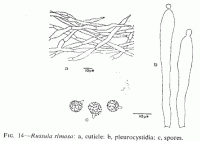 | 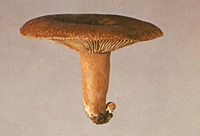
Caption: Fig. 34 - Russula rimosa (x 3/4). | 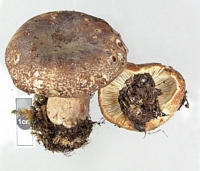
Owner: J.A. Cooper | 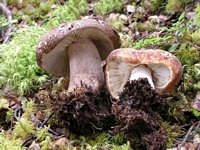
Owner: J.A. Cooper | 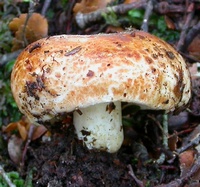
Owner: P. Leonard |
Article: McNabb, R.F.R. (1973). Russulaceae of New Zealand. 2. Russula Pers. ex S.F. Gray. New Zealand Journal of Botany 11(4): 673-730 (http://www.rsnz.org/publish/abstracts.php).
Description: pileus: 6-10 cm diam., hemispherical when young,
centrally depressed at maturity, slightly viscid under wet conditions, otherwise
dry, subpruinose or finely rimose-areolate in centre, adpressed-squamulose or
finely rimose towards margins, deep fawn, brown, or dark brown in centre, paling
to light brown, brownish orange, or greyish brown with a mottled appearance
towards margins; margins entire, thick, non pectinate. Cuticle slightly gelatinised
at maturity, composed of ± repent, obliquely ascending, or occasionally
erect, interwoven, thin-walled, septate hyphae 2.5-7 µm diam., with yellow-brown
contents in KOH, terminal cells tapering apically, unspecialised; pilocystidia
absent. lamellae: adnate to subdecurrent moderately crowded,
moderately thick, simple or occasionally forked near stipe, to 10 mm deep, creamy
white to sordid creamy white with pallid grey tints, not discoloured at maturity,
lamellulae rare. stipe: 3-6 cm long, ± equal or slightly expanded
basally, 1.5-3 cm diam., solid or slightly hollowed at maturity, dry, finely
felted to subvelutinate, pallid brown or greyish brown, paling to brownish white
basally; flesh sordid white to brownish white, rather coarsely granular, browning
slightly on exposure to air. Cuticle composed of interwoven, repent, thin-walled,
septate hyphae 2.5-7.5 µm diam., terminal cells unspecialised, tapering apically,
projecting at right angles or obliquely and forming a loose palisade; caulocystidia
absent. spores: spore print white; spores broadly ovate,
obovate, or broadly elliptical, prominently obliquely apiculate, apiculus to
2.5 µm, long, 8.5-10.5 X 7.5-9.5 µm, ornamentation of moderately dense, amyloid
verrucae and crests to 0.7 µm high, joined by fine amyloid ridges and forming
an almost complete reticulum; plage absent. hymenium: basidia hyaline, clavate,
42-61 X 9-13 µm, 4-spored, sterigmata to 7.5 µm long; pleurocystidia scattered,
numerous, fusiform to subclavate, thin-walled, contents refractive in KOH, projecting
to 20 µm beyond basidia, apices acuminate, capitulate, or mucronate, 55-100
X 6.5-11 µm: cheilocystidia sparse, similar to pleurocystidia but shorter. hymenophoral
trama: heteromerous, ± bilateral; mediostratum
composed of sphaerocysts and connective hyphae, pigmented and sharply delimited
from the lateral stratum composed of rather loosely interwoven connective hyphae.
context of pileus:
white to sordid white, browning slightly on exposure; structure heteromerous,
clamp connections absent. taste: lamellae and context mild. chemical characters: formalin on context—slowly
vinaceous; phenol on context—slowly deep vinaceous; FeS04 on context—rapidly
dull greyish green; guaiacol on stipe base— rapidly salmon pink, darkening with
time; KOH on pileus—darkening slightly; on context—faint yellowing; NH4OH on
pileus and context— n.r.
Habitat: >Solitary or in pairs under Leptospermum.
Article: Pennycook, S.R. (2003). Nomenclatural revisions of New Zealand agarics and boletes. New Zealand Journal of Botany 41(3): 501-502 (http://www.rsnz.org/publish/abstracts.php).
Description: In a final paper published after his premature death in 1972, New Zealand mycologist Ross
McNabb described 32 new endemic species of the genus Russula (McNabb 1973). All of these
continue to be accepted as distinct taxa, but three of his names,Russula atrovirens, R.
littoralis, and R. rimosa, are homonyms of earlier names, and are thus nomina illegitima,
requiring new names. The first of the three was renamed by Buyck (1990) [as Russula atroviridis, for R. atrovirens]; the other two
are renamed here.
Russula rimulosa Pennycook, nom. nov.ç
Russula rimosa McNabb, N.Z. J. Bot. 11,
698 (1973), nom. illegit., non Murrill 1946.
ETYMOLOGY: referring to McNabb's description of the pileus as "finely rimose".
|